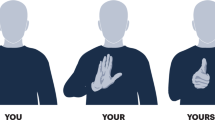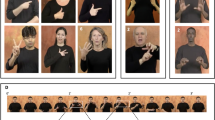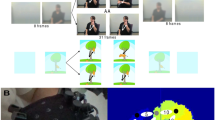Abstract
Deaf children whose access to usable conventional linguistic input, signed or spoken, is severely limited nevertheless use gesture to communicate1,2,3. These gestures resemble natural language in that they are structured at the level both of sentence4 and of word5. Although the inclination to use gesture may be traceable to the fact that the deaf children's hearing parents, like all speakers, gesture as they talk6, the children themselves are responsible for introducing language-like structure into their gestures7. We have explored the robustness of this phenomenon by observing deaf children of hearing parents in two cultures, an American and a Chinese culture, that differ in their child-rearing practices8,9,10,11,12 and in the way gesture is used in relation to speech13. The spontaneous sign systems developed in these cultures shared a number of structural similarities: patterned production and deletion of semantic elements in the surface structure of a sentence; patterned ordering of those elements within the sentence; and concatenation of propositions within a sentence. These striking similarities offer critical empirical input towards resolving the ongoing debate about the ‘innateness’ of language in human infants14,15,16.
This is a preview of subscription content, access via your institution
Access options
Subscribe to this journal
Receive 51 print issues and online access
$199.00 per year
only $3.90 per issue
Buy this article
- Purchase on Springer Link
- Instant access to full article PDF
Prices may be subject to local taxes which are calculated during checkout



Similar content being viewed by others
References
Moores, D. F. in Language Perspectives (eds Schiefelbusch, R. L. & Lloyd, L. L.) 377–878 (University Park, Baltimore, (1974)).
Tervoort, B. T. Esoteric symbolism in the communication behavior of young deaf children. Am. Ann. Deaf 106, 436–480 (1961).
Fant, L. Ameslan (National Association of the Deaf, Silver Springs, MD, (1972)).
Goldin-Meadow, S. & Feldman, H. The development of language-like communication without a language model. Science 197, 401–403 (1977).
Goldin-Meadow, S., Mylander, C. & Butcher, C. The resilience of combinatorial structure at the word level: morphology in self-styled gesture systems. Cognition 56, 195–262 (1995).
Feyereisen, P. & deLannoy, J.-D. Gesture and speech (Cambridge Univ. Press, New York, (1991)).
Goldin-Meadow, S. & Mylander, C. Gestural communication in deaf children: the non-effects of parental input on language development. Science 221, 372–374 (1983).
Miller, P. J., Wiley, A., Fung, H. & Liang, C.-H. Personal storytelling as a medium of socialization in Chinese and American families. Child Development 68, 557–568 (1997).
Stevenson, H. W. et al. Contexts of achievement. Monogr. Soc. Res. Child Dev. 55 1–119 ((1990)).
Young, N. F. Socialization patterns among the Chinese of Hawaii. Amerasia J. 1, 31–51 (1972).
Chen, C. & Uttal, D. H. Cultural values, parents' beliefs, and children's achievement in the United States and China. Hum. Dev. 31, 351–358 (1988).
Wang, X-l., Mylander, C. & Goldin-Meadow, S. in Research on Family Resources and Needs Across the World (ed. Cusinato, M.) 363–374 (Edizioni Universitarie di Lettere Economia, Diritto, Italy, (1996)).
McNeill, D. & Duncan, S. D. in Language and Gesture: Window into Thought and Action (ed. McNeill, D.) (New Lexington, San Francisco, submitted).
Chomsky, N. Aspects of the Theory of Syntax (MIT Press, Cambridge, MA, (1965)).
Pinker, S. The Language Instinct (Harper Collins, New York, (1995)).
Gleitman, L. R. & Newport, E. L. in Language, Vol. 1, Invitation to Cognitive Science Series (eds Gleitman, L. R. & Liberman, M.) 1–24 (MIT Press, Cambridge, MA, (1995)).
Petitto, L. A. in The Development of Language and Language Researchers (ed. Kessel, F.) 187–221 (Erlbaum Associates, Hillsdale, (1988)).
McNeill, D. Hand and Mind (Univ. Chicago Press, Chicago, (1992)).
Dixon, R. M. W. Ergativity (Cambridge Univ. Press, New York, (1994)).
Silverstein, M. in Grammatical Categories in Australian Languages (ed. Dixon, R. M. W.) 112–171 (Australian Institute of Aboriginal Studies, Canberra, (1976)).
Zar, J. H. Biostatistical Analysis 2nd edn (Prentice-Hall, Englewood Cliffs, (1984)).
Goldin-Meadow, S., Butcher, C., Mylander, C. & Dodge, M. Nouns and verbs in a self-styled gesture system: what's in a name? Cogn. Psychol. 27, 259–319 (1994).
Goldin-Meadow, S. & Mylander, C. Gestural communication in deaf children: the effects and non-effects of parental input on early language development. Monogr. Soc. Res. Child Dev. 49, 1–151 ((1984)).
Siegel, S. Nonparametric Statistics for the Behavioral Sciences (McGraw-Hill, New York, (1956)).
Goldin-Meadow, S. Book review of Kanzi: The Ape at the Brink of the Human Mind by Savage-Rumbaugh, S. & Lewin, R. Int. J. Primatol. 17, 145–148 (1996).
Wimsatt, W. in Integrating Scientific Disciplines (ed. Bechtel, W.) 185–208 (Martinus-Nijhoff, Dordrecht, (1986)).
Acknowledgements
We thank L. Barsalou, J. Huttenlocher, B. Keysar, M. K. McClintock, P. Miller, D.McNeill and W. Wimsatt for comments; S. Duncan for help in collecting the Taiwanese data; and F. Bechter and M.-Y. Zheng for help in transcribing the videotapes. Supported by grants from the National Institute on Deafness and other Communciation Disorders and the NSF.
Author information
Authors and Affiliations
Corresponding author
Rights and permissions
About this article
Cite this article
Goldin-Meadow, S., Mylander, C. Spontaneous sign systems created by deaf children in two cultures. Nature 391, 279–281 (1998). https://doi.org/10.1038/34646
Received:
Accepted:
Issue Date:
DOI: https://doi.org/10.1038/34646
This article is cited by
-
Infants differentially extract rules from language
Scientific Reports (2021)
-
Birdsong normalized by culture
Nature (2009)
-
Frühe Hörerfahrung und sensible Entwicklungsphasen
HNO (2009)
Comments
By submitting a comment you agree to abide by our Terms and Community Guidelines. If you find something abusive or that does not comply with our terms or guidelines please flag it as inappropriate.



